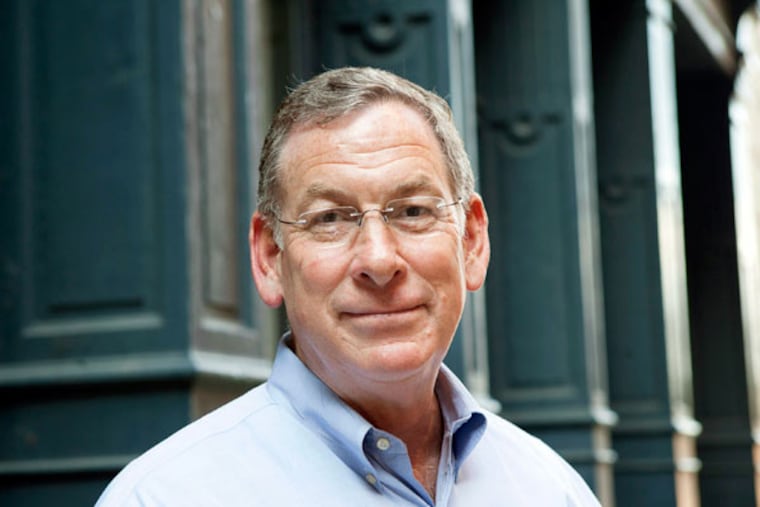Sam Katz: I don’t ‘trust the process’ (or concept) of the downtown 76ers arena
I know this city, and I know arenas. Consider me highly skeptical of the 76ers' plans for a downtown arena. Here's why.

Kudos to the Philadelphia 76ers for a brilliant opening salvo in pursuit of a new downtown arena. These pages have been filled with opinions that paint an alluring rebranding of Market Street East. The arena announcement has generated excitement at a time when civic optimism is running low.
I know Philadelphia — I ran for mayor three times and I produce historical documentaries about it — but I also know something about building sports facilities. For more than a decade, I arranged private and public funding for arenas and stadiums from Miami to Portland, including the Wells Fargo Center here in South Philly. I am clear-eyed about the complexity of financing and developing these massive projects.
When it comes to the idea of a downtown 76ers arena, consider me highly skeptical. Here’s why:
A downtown arena could kick-start an unraveling of the South Philly Sports Complex. In the late 1990s, when Veterans Stadium was starting to run its course, the Phillies and the Eagles committed to South Philly and built Citizens Bank Park and Lincoln Financial Field. Nearly $500 million of state and city investment flowed into both new stadiums. The Flyers and Sixers had long been there at the Spectrum. Wells Fargo Center opened in 1996. With a four-team Sports Complex in place, the Nova Care Center, Xfinity Live!, and Live Casino were added to the mix.
The complex’s easy accessibility — SEPTA, highways and bridges, vehicular parking — is the envy of many cities. Across Broad Street, FDR Park is greatly improved and served as a popular host of the Philadelphia Flower Show. Nearby, the Navy Yard is an expanding economic zone.
By trying to break away, the Sixers arena proposal will open a Pandora’s box and undo the synergy that took decades to build.
Their lease at Wells Fargo expires in 2031. Lincoln Financial Field and Citizens Bank Park will each be 30 years old in 2033/34. Will one team’s departure cause the others to ponder their plans?
The Philadelphia market will struggle to support four distinct major-league sports facilities. The private financing promised by the Sixers requires long-term, contractually obligated income to secure project loans. The income generated from the combination of luxury seating (suites and club seats), naming rights, concessions, advertising, and major tenant leases (NHL/NBA) makes a project “bankable.” At the Sports Complex, parking income is also a key revenue source. Can a fourth building, on its own, with just one major team (and much less parking), acquire the cash flow sufficient to make it work? I doubt it.
The business to support two major indoor arenas simply doesn’t exist. A professor of sports management suggested that 275 nights at the arena (games and concerts) is possible “if they do it right.” This is a pipe dream, totally disconnected from both experience and reality. The Wells Fargo Center hosted roughly 230 events in 2019. That same year, the $1 billion Barclays Center in Brooklyn hosted 194 events, including games played by the NHL’s New York Islanders, who now play in their own new arena. The concert business is a highly competitive one and is being disrupted by smaller venues, a preference for one-night stadium concerts (with more than 40,000 seats) instead of two nights in an arena (which usually have about 20,000 seats), and shifting artists’ popularity.
These business issues are not our business. Since 1996, the Sixers have been a tenant at the Wells Fargo Center, which is owned by Comcast, which also owns the Flyers. To the Sixers, this is not ideal; every NBA and NHL team wants to own its building and not be a tenant of the other. But this is a business issue between two private parties, and one the city shouldn’t be forced into joining.
This project will require significant public investment, cause major disruptions to Chinatown and Market East, and yield modest economic development benefits. The Sixers know their proposed arena will not make money. Their upside has to be recovered through a thriving mall, new residential development, and a lively streetscape. Here’s the rub: When, for at least 150 nights each year, no events are scheduled — the “dark nights” of the arena business — the bustling district will be empty. There will also be significant costs from the arena’s disruption to surrounding neighborhoods.
A new sports arena will demand attention when Philadelphia can least provide it. In the next year-plus, the city will host critical municipal elections, which will usher in a new mayor and many new members of City Council. A new sports and entertainment district in Center City is simply not an important policy priority. With street violence, massive inequality, and continuing distress in education, health, housing, and opportunity, there are more important public policy issues on the table.
Building an arena is as much a process as is building a championship team. Both require public trust. For all the reasons I’ve identified, I don’t trust a process designed to produce a single-tenant downtown arena. I would encourage the Sixers to take it off the table.
Sam Katz is a documentary filmmaker who ran three races for mayor and spent more than two decades of his career in public finance.